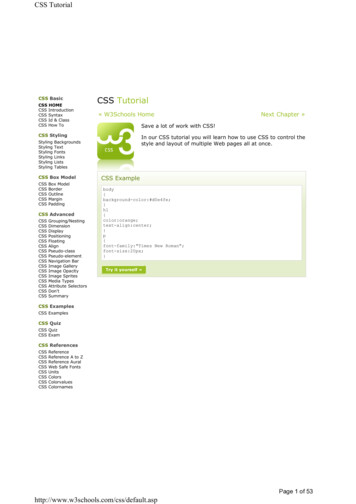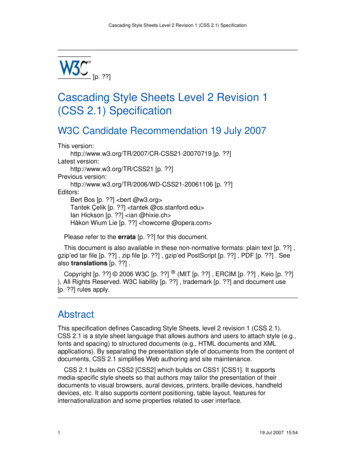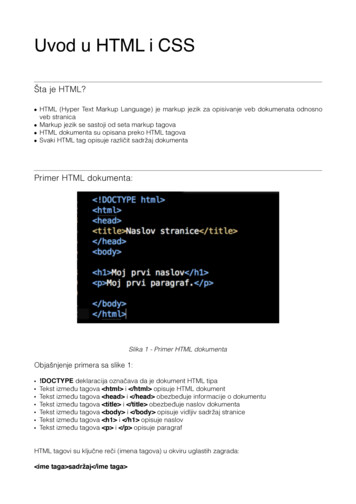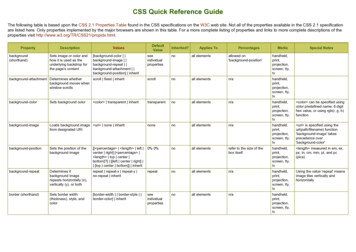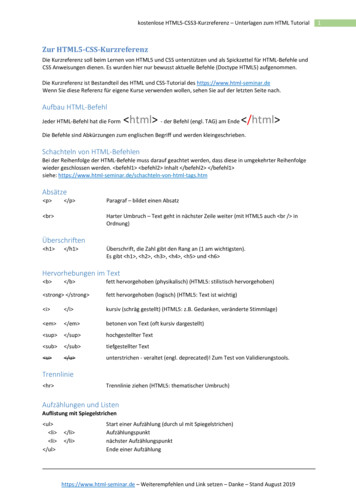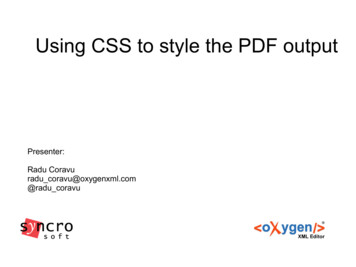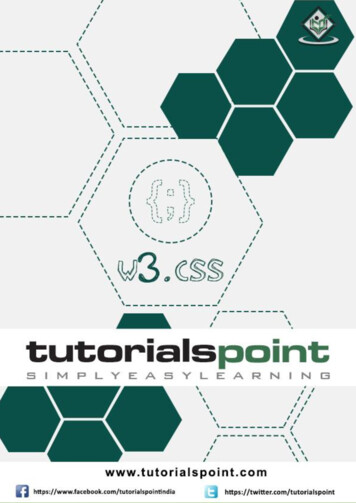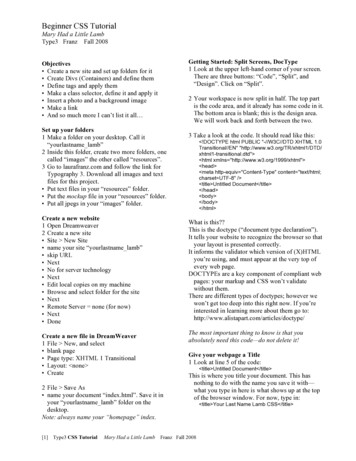
Transcription
CSS Study GuideA stylesheet (CSS file) provides formatting for one or many web pages (HTML files).Example:Web page (HTML file)Web page (HTML file)Web page (HTML file) html head title my title /title link href "mystyles.css" rel "stylesheet" type "text/css"/ /head Style sheet (CSS file)p{color:red;} body /body /html Link tagThe link tag is required inside the head tag to tell the HTML file where to go to get its style rules/formatting. Itmust be of the format: link href "mystyles.css" rel "stylesheet" type "text/css"/ Where mystyles.css is the name of the CSS file where style rules are found.rel "stylesheet" type "text/css" is required to tell the browser it's a stylesheet file.The above assumes that the CSS file is in the same folder as the HTML file. If not, then the HREF attribute needs to pointto the CSS file. Example: href ".\styles\mystyles.css" would be in a "styles" folder next to the folder that contains theHTML file.CSS RulesCSS rules are created inside the CSS file, and are of the form:Selector {property: value;property2: value2;}Where selector determines which HTML tags the rule applies to.Property is a CSS property name, and value is the value to set the property to.Note that the { } : and ; are required.Multiple properties can be listed, each separated by semi-colons.
SelectorsThere are 5 types of selectors:1.2.3.4.5.HTML tag selectorID selectorClass selectorPseudo-class selector (for hover, visited, etc.)Combinations of the above with modifiersHTML SelectorAny HTML tag can be used as a selector. When used, all tags on the HTML web page will get the properties (formatting)applied to it for that rule. Examples:p{color:red;}/* sets all paragraphs on the page to have red text */h3 {color:blue;}/* sets all heading level 3s on the page to have blue text */td {color: green;}/* sets all tds inside tables on the page to have green text */ID SelectorUsing ID allows the author to mark ONE (and only ONE) tag for each web page with a unique name, and apply formattingfor only that tag. To mark the HTML tag, use id "name", such as: p id "redpara" This is a paragraph /p td id "bluecell" This is a table cell /td Now, a rule can be applied using the hashtag selector: #idname#redpara{ /* only the tag with id "redpara" will get red text */color:red;}#bluecell{ /* only the tag with id "bluecell" will get blue text */color:blue;}such as:
Class SelectorUsing CLASS allows the author to mark MANY tags on each web page with a class name, and apply formatting for thosetags. To mark the HTML tag, use class "name", such as: p class "bluebackground" This is a paragraph /p p class "bluebackground" This is a another paragraph /p td class "bluebackground italtext" This is a cell in a table /td Now, a rule can be applied using the period (.) selector: .classname- Both bluebackground and italtext rules applysuch as:.bluebackground{ /* only the tags with class " bluebackground" will get blue background text */background-color:blue;}To allow more flexibility, HTML tag selectors can be combined with Class selectors by placing the HTML tag name beforethe period. For example:p.bluebackground{ /* only the p tags with class " bluebackground" will get blue background text */background-color:blue;}td. bluebackground{ /* only the td tags with class " bluebackground" will get blue background with red font text */background-color:blue;color:red;}.italtext{/* all tags with class "italtext" will become italic */font-style:italic;}
Property namesFor a full reference of property names to use, refer to w3schools.com (use the Learn CSS link on the left).Here are some common , "Garamond", :bold;list-style-type:circle;list-style-image: url('sqpurple.gif');border: 1px solid 0px;padding:15px;float:left; (must be combined with width)float:right; (must be combined with width)sets text colorsets background colorsets the background imagesets how the background image repeatssets horizontal alignment of text and other tags within the tagcan also use center, leftsets vertical alignment of text and other tags within the tagcan also use middle, bottomdecoration values: none, overline, line-through, underline, blinkleft indentsets font names, chosen in order if they exist on the computeruse serif or sans-serif as generic font namesitalic text. Can also have value:normal;sets font sizesets bold font. Can also have value:normal;sets bullet type for lists on ul and ol tag.sets bullet type to a small imagesets a 1 pixel wide black solid border. Use on table , td , th removes space between td borders. Use on table sets width or height of the tag. Can also use %, width:50%;sets extra white space padding in td tags in tablessets a div to allow content to flow to the right of itsets a div to allow content to flow to the left of it
CSS LayoutCSS Layout is about using DIVs to define boxes on a page to act as a page template, and hold specific pieces of contentthat may change across pages. A web site may contain templates for the home page, for sub-pages, and for productdetail pages (for a commerce site like Amazon, for instance). With just a few templates, content can be inserted tocreate a consistent set of pages that looks, feels, and interacts similarly across the whole site, even though thousands ofproducts may be available. This makes the site friendly and easy to use if done well.Here's an example template:LogoBannerNavigationMainContentSideSideA container DIV can be used to center all ofthe content within the browser. It musthave a style rule, such right:auto;}FooterAssume that the names above match the classes of each DIV. For example: div class "Logo" img src "logo.jpg"/ /div To get a layout like the above, some of the DIVs must be set to float, and must be given widths. Floating a DIV allows thecontent to flow along side of it. The following styles must be used:.Logo{float: t{float: left;width:700px;}.Side{width:200px;}All DIVs on the page likely have a height property set as well (not shown above).
The CSS Box ModelBorder PropertiesPropertyDescriptionExample ValuesborderSpecify thickness, style, color in order10px solid #FF0000bordercolorColor to fill border#EDEDEDborder-widthWidth of border on all 4 sides10pxborder-styleStyle of border on all 4 sidesnone, hidden, dotted, dashed, double, groove, insert,outset, ridge, solidborderCombined styles for width, style, colorin that order10px solid -rightStyle for one side of the borders10px solid #FF0000Padding /Margin PropertiesPropertyDescriptionExample Values
paddingPadding for all 4 sides:- One value for all 4 sides- In clock-wise order:Top Right Bottom LeftPadding for one side of the box5px2px 3px 3px 2px(T R BL )10pxMargin for all 4 sides:- One value for all 4 sides- In clock-wise order:Top Right Bottom LeftMargin for one side of the box5px2px 3px 3px 2px(T R BL )10pxPropertyDescriptionExample ValuesfloatSet a block to one side of the pageThe floating block must have a widthTurns off float effectsleft, right, nonedisplayHow an HTML element should be display.{display:none} hides the element and doesnot take up any space.inline, block, nonevisibilityShow or hide an element.{visibility:hidden} hides the element but stilltakes up the same space.visible, om,margin-leftOther Propertiesclearleft, right, both, noneThe above can be used to automatically center a container DIV (that has a fixed width) on a page.If you want a DIV to never flow next to a FLOATED DIV (or other element), setting:clear: both;will always put that DIV on a new line, at the left side of the page.
1. HTML tag selector 2. ID selector 3. Class selector 4. Pseudo-class selector (for hover, visited, etc.) 5. Combinations of the above with modifiers HTML Selector Any HTML tag can be used as a selector. When used, all tags on the HTML web page will get the properties (formatting) applied to it for that rule. Examples:
